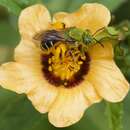Distribution
provided by Catalog of Hymenoptera in America North of Mexico
Tex. (Brownsville); Mexico (Baja California, Campeche, Chiapas, Colima, Distrito Federal, Guanajuato, Guerrero, Hidalgo, Jalisco, Mexico, Michoacan, Morelos, Nayarit, Oaxaca, Puebla, San Luis Potosi, Sinaloa, Sonora, Tabasco, Tamaulipas, Tlaxcala, Veracruz, Yucatan, and Veracruz; absent form Central Plateau), south to Central America (Belize, Costa Rica, El Salvador, Guatemala, Honduras, Nicaragua, and Panama), South America (Colombia, Ecuador, Peru, and Venezuela), and the West Indies (Trinidad).
- bibliographic citation
- Catalog of Hymenoptera in America North of Mexico. 1979. Prepared cooperatively by specialists on the various groups of Hymenoptera under the direction of Karl V. Krombein and Paul D. Hurd, Jr., Smithsonian Institution, and David R. Smith and B. D. Burks, Systematic Entomology Laboratory, Insect Identification and Beneficial Insect Introduction Institute. Science and Education Administration, United States Department of Agriculture.
General Ecology
provided by Catalog of Hymenoptera in America North of Mexico
In Costa Rica females of a nesting population studied by Eickwort and Eickwort (1962. Kans. Ent. Soc., Jour. 42: 427-429, 448) collected pollen only from the flowers of Sida (S. acuta, S. rhombifolia) mainly from 0800 to 1300 hours, but visited these and other flowers for nectar. However, as they point out, the females of this species are known to collect pollen from other sources elsewhere in their range.
- bibliographic citation
- Catalog of Hymenoptera in America North of Mexico. 1979. Prepared cooperatively by specialists on the various groups of Hymenoptera under the direction of Karl V. Krombein and Paul D. Hurd, Jr., Smithsonian Institution, and David R. Smith and B. D. Burks, Systematic Entomology Laboratory, Insect Identification and Beneficial Insect Introduction Institute. Science and Education Administration, United States Department of Agriculture.
Distribution
provided by Catalog of Hymenoptera in America North of Mexico
Tex. (Brownsville); Mexico (Baja California, Campeche, Chiapas, Colima, Distrito Federal, Guanajuato, Guerrero, Hidalgo, Jalisco, Mexico, Michoacan, Morelos, Nayarit, Oaxaca, Puebla, San Luis Potosi, Sinaloa, Sonora, Tabasco, Tamaulipas, Tlaxcala, Veracruz, Yucatan, and Veracruz; absent form Central Plateau), south to Central America (Belize, Costa Rica, El Salvador, Guatemala, Honduras, Nicaragua, and Panama), South America (Colombia, Ecuador, Peru, and Venezuela), and the West Indies (Trinidad).
- bibliographic citation
- Catalog of Hymenoptera in America North of Mexico. 1979. Prepared cooperatively by specialists on the various groups of Hymenoptera under the direction of Karl V. Krombein and Paul D. Hurd, Jr., Smithsonian Institution, and David R. Smith and B. D. Burks, Systematic Entomology Laboratory, Insect Identification and Beneficial Insect Introduction Institute. Science and Education Administration, United States Department of Agriculture.
General Ecology
provided by Catalog of Hymenoptera in America North of Mexico
In Costa Rica females of a nesting population studied by Eickwort and Eickwort (1962. Kans. Ent. Soc., Jour. 42: 427-429, 448) collected pollen only from the flowers of Sida (S. acuta, S. rhombifolia) mainly from 0800 to 1300 hours, but visited these and other flowers for nectar. However, as they point out, the females of this species are known to collect pollen from other sources elsewhere in their range.
- bibliographic citation
- Catalog of Hymenoptera in America North of Mexico. 1979. Prepared cooperatively by specialists on the various groups of Hymenoptera under the direction of Karl V. Krombein and Paul D. Hurd, Jr., Smithsonian Institution, and David R. Smith and B. D. Burks, Systematic Entomology Laboratory, Insect Identification and Beneficial Insect Introduction Institute. Science and Education Administration, United States Department of Agriculture.
Biology
provided by Halictidae LifeDesk
Eickwort and Eickwort (1969) describe the biology of this species near Turrialba, Costa Rica. Agapostemon nasutus is a bright green and black (female), and bright green and black and yellow (male) bee that occurs from Texas to Venezuela, Colombia, and southward west of the Andes to Peru. The species is apparently active year-round at the authors’ study site.
This species is communal, nesting in groups of 1-15 females, in which each female provisions her own brood cells and reproduces. Females may enter burrows dug by other females and construct and provision new cells there, thus females nesting together are not necessarily closely related. During the time of the study (July and August), 68% of emerging new offspring were males.
This bee's nest architecture is described by Sakagami and Michener (1962): Nest architecture is Type II: Lateral burrows branch off from the main burrow. These lateral burrows contain cells constructed in series (1-6 cells), such that each blocks the one previously constructed. Banks are the only known substrate used for nesting. Nests may contain more than one entrance, presumably due to multiple females constructing burrows, and may reach 62 cm deep.
Agapostemon nasutus
provided by wikipedia EN
Agapostemon nasutus is a species of sweat bee in the family Halictidae.[1][2][3]
Subspecies
These two subspecies belong to the species Agapostemon nasutus:
-
Agapostemon nasutus gualanicus Cockerell
- Agapostemon nasutus nasutus
References
- license
- cc-by-sa-3.0
- copyright
- Wikipedia authors and editors
Agapostemon nasutus: Brief Summary
provided by wikipedia EN
Agapostemon nasutus is a species of sweat bee in the family Halictidae.
- license
- cc-by-sa-3.0
- copyright
- Wikipedia authors and editors

